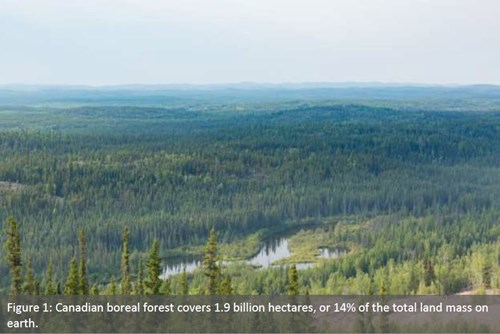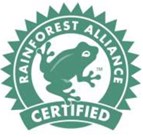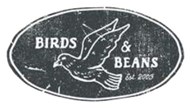Role Of Forests In Fighting Climate Change
Friday, July 26, 2019Overview
The previous blog discussed the role of oceans in fighting climate change. We learnt that without the important carbon sink role that our oceans play, our contemporary climate crisis would be much worse. The average surface temperature of the Earth, compared to the pre-industrial era, has increased by 0.8° Celsius, which is bad, but it could have been much worse if the oceans had not absorbed 38% of the Carbon Dioxide (CO2) emitted due to fossil fuel burning. Forests, just like the oceans, also play an important role in fighting climate change. 71% of Earth’s surface is oceans while the remaining 29% is land. Forests cover nearly 30% of the land surface, but each year they absorb nearly 1/3 of the human emitted CO2.
A forest is considered a carbon sink when it absorbs more carbon than it releases and a carbon source when it releases more carbon than it absorbs. CO2 is absorbed by the plantsfrom the atmosphere to produce organic carbon compound, such as wood and cellulose. Through photosynthesis, they release oxygen as a byproduct.  CO2 is released when a tree dies due to disease, wild fire, deforestation and/or decomposition. Overall, world forests are incredibly efficient at absorbing and storing carbon, as they represent ~45% of the total carbon stores on land. However, forests are losing their ability to be carbon sinks and are becoming more of a carbon source. For example, 65% of Canada’s boreal forest, which is referred to as managed forest, i.e., directly under human influence, is no longer a net carbon sink. It released 78 megatons of CO2 in 2016; therefore, is a net carbon source. For comparison, Canada’s annual average emission is roughly 700 megatons. Our managed forest is a source of CO2, in-part, due to natural disturbances such as forest fires, and pine beetle.
CO2 is released when a tree dies due to disease, wild fire, deforestation and/or decomposition. Overall, world forests are incredibly efficient at absorbing and storing carbon, as they represent ~45% of the total carbon stores on land. However, forests are losing their ability to be carbon sinks and are becoming more of a carbon source. For example, 65% of Canada’s boreal forest, which is referred to as managed forest, i.e., directly under human influence, is no longer a net carbon sink. It released 78 megatons of CO2 in 2016; therefore, is a net carbon source. For comparison, Canada’s annual average emission is roughly 700 megatons. Our managed forest is a source of CO2, in-part, due to natural disturbances such as forest fires, and pine beetle.
Deforestation, Climate Change, and Forest Fires
Not only the Canadian boreal forest, but the forests around the world are becoming net carbon sources, thereby amplifying climate change and global warming. Each year 7.6 million hectares of forest, equivalent of 27 soccer fields every minute, is lost due to the deforestation. Besides deforestation, forest fragmentation is another big source of CO2. Globally, deforestation and forest fragmentation combined accounts for 15% of the greenhouse gas emissions. When forest are cut down, the CO2 stored in the trees is released into the atmosphere if the wood is burned or even as it starts to decay. These greenhouse gases form a positive feedback loop. First, the greenhouse gases released due to the deforestation and forest fragmentation contribute to climate change. Second, due to climate change, forest are getting drier, which in turn is increasing the intensity and frequency of forest fires and releasing lots of greenhouse gases, thereby adding further to climate change. The impact of climate change is much greater on the Canadian boreal forest than many other places.
 Global average temperatures have increased by 0.8° Celsius since 1880. The average surface temperature of Canada, however, has increased by 1.7° Celsius between 1948 and 2016. The increasing temperature creates drier conditions in the boreal forest, especially in the spring. As a result, studies have predicted that by the end of 21st century the forest fires could burn twice as much area every year in Canada. Currently on average 2.5 million hectares of forest is burned in Canada annually. Although fire is a natural phenomenon in boreal forest, as it helps with reproduction and renewal of the forest, climate change will have a negative impact on the postfire regeneration of boreal forest. With hotter-drier conditions, tree seedlings will have lower survival rates. Already uncontrollable, severe forest fires are posing a significant threat to many communities in Canada. The Fort McMurray wildfire, for example, proved to be the costliest natural disaster in Canadian history resulting in an economic impact of $8.9 billion.
Global average temperatures have increased by 0.8° Celsius since 1880. The average surface temperature of Canada, however, has increased by 1.7° Celsius between 1948 and 2016. The increasing temperature creates drier conditions in the boreal forest, especially in the spring. As a result, studies have predicted that by the end of 21st century the forest fires could burn twice as much area every year in Canada. Currently on average 2.5 million hectares of forest is burned in Canada annually. Although fire is a natural phenomenon in boreal forest, as it helps with reproduction and renewal of the forest, climate change will have a negative impact on the postfire regeneration of boreal forest. With hotter-drier conditions, tree seedlings will have lower survival rates. Already uncontrollable, severe forest fires are posing a significant threat to many communities in Canada. The Fort McMurray wildfire, for example, proved to be the costliest natural disaster in Canadian history resulting in an economic impact of $8.9 billion.
What can we do?
In Canada, our trees are cut for lumber and pulp and paper production. The three Canadian systems are the Canadian Standards Association's Sustainable Forest Management Standards (CSA), the Forest Stewardship Council Standards (FSC) and the Sustainable Forestry Initiative (SFI). The CSA and SFI standards are recognized internationally by the Programme for the Endorsement of Forest Certification (PEFC). When you purchase wood and paper products ensure they are endorsed by one of these certifications which promote sustainable forestry. When possible purchase paper products with post-consumer content which reduce the need for trees.
One of the biggest reasons for deforestation in the tropics is food production. The increase in the demand of popular food items such as palm oil, coffee, and soybean often result in deforestation as the farmers clear more land to increase their production. The loss of forest is ecologically destructive and, as we have already seen, contributes to the climate change. Consumers, however, can buy products that promote sustainable food production. There are voluntary certifications that can provide incentives to the famers to farm more sustainability. By buying food or products certified by specific organizations, you can have a significant impact in reducing our global deforestation. Here are a few examples of these certifications and what they aim to achieve.
 Rainforest Alliance is an international non-profit organization that works with farmers and businesses promoting sustainable farming and forestry. Among many other things, the Rainforest Alliance promote sustainable coffee production that does not require deforestation and promote varieties of coffee that are shade tolerant, thereby, decreasing the deforestation. In order to obtain rainforest certification, coffee farmers are encouraged to restore certain level of canopy cover in a forest. You can learn more about Rainforest Alliance at: https://www.rainforestalliance.org
Rainforest Alliance is an international non-profit organization that works with farmers and businesses promoting sustainable farming and forestry. Among many other things, the Rainforest Alliance promote sustainable coffee production that does not require deforestation and promote varieties of coffee that are shade tolerant, thereby, decreasing the deforestation. In order to obtain rainforest certification, coffee farmers are encouraged to restore certain level of canopy cover in a forest. You can learn more about Rainforest Alliance at: https://www.rainforestalliance.org
 Bird Friendly is another certification that provides organic coffee which is grown under shade, thereby, preserves the native forest for wildlife, such as bird. The restored forest is certified by the Smithsonian Migratory Bird Centre. You can learn more about Bird Friendly coffee at: https://birdsandbeans.ca
Bird Friendly is another certification that provides organic coffee which is grown under shade, thereby, preserves the native forest for wildlife, such as bird. The restored forest is certified by the Smithsonian Migratory Bird Centre. You can learn more about Bird Friendly coffee at: https://birdsandbeans.ca
Picture Credit
Peupleloup, accessed on Feb 13, 2020, [picture cropped] retrieved from https://flickr.com/photos/10601432@N08/2968075180
Darren RD, accessed on Feb 13, 2020, [cropped] retrieved from https://commons.wikimedia.org/wiki/File:Landscape_view_of_wildfire_near_Highway_63_in_s outh_Fort_McMurray_(cropped).jpg
Impressions of a Boreal Forest, by Kerbla Edzerdla. 15 June 2017. https://commons.wikimedia.org/wiki/File:Impressions_Of_A_Boreal_Forest_(216534525).jpeg
Further Readings
https://www.nrs.fs.fed.us/niacs/forests/
https://earthobservatory.nasa.gov/features/CarbonCycle
https://www.getprepared.gc.ca/cnt/hzd/wldfrs-en.aspx
https://climateatlas.ca/forest-fires-and-climate-change
https://www.audubon.org/news/how-choose-bird-friendly-coffee
http://www.cgd.ucar.edu/events/20130729/files/Bonan-2008.pdf
https://www.nrs.fs.fed.us/pubs/jrnl/2011/nrs_2011_pan_002.pdf
https://www.audubon.org/news/how-choose-bird-friendly-coffee
https://www.sciencedaily.com/releases/2019/03/190312151236.htm
https://www.alberta.ca/assets/documents/Wildfire-KPMG-Report.pdf
https://esajournals.onlinelibrary.wiley.com/doi/full/10.1002/ecs2.2568
https://www.iucn.org/resources/issues-briefs/forests-and-climate-change
https://www.nrcan.gc.ca/forests/topics/climate-change/forest-carbon/13085
https://www.worldwildlife.org/threats/deforestation-and-forestdegradation#causes
https://www.src.sk.ca/blog/how-climate-change-willshape-future-canadas-borealforest
https://www.cbc.ca/news/canada/calgary/canada-forests-carbon-sink-orsource-1.5011490
https://royalsociety.org/- /media/Royal_Society_Content/policy/publications/2001/9996.pdf
https://www.sfmcanada.org/en/sustainable-forest-management/embracing-third-partycertification
Blog Posts
- What is Climate Change
- Drought: What Can We Do?
- Migration and Climate Change; a Complicated Relationship (Part 1)
- Migration and Climate Change; a Complicated Relationship (Part 2)
- Climate Change and Birds’ Resources
- Ladder to Extinction
- Arctic Warming and Ecosystem Impacts
- Climate Change Connection to Mountain Pine Beetle
- Tackling Climate Change Denialism
- Impact of Climate Change on Bluebirds
- An Introduction to Climate Change
- Great Decline of Aerial Insectivores
- Role of Oceans in Fighting Climate Change
- Role Of Forests In Fighting Climate Change
- Impact of Climate Change on Shorebirds
- Impact of Hurricanes and Climate Change on Birds
- An Introduction to Climate Change.
- Impact of Forest Fires, and Climate Change on the Nature
- Impacts of Climate Change on Owls
- Impacts of Climate Change on Birds of Prey
- Whitebark Pine and Clark's Nutcracker
- COVID 19 & The Environment
- Impact of Global Warming on Bird Anatomy and Colour Polymorphism
- Climate Change & West Nile Virus
- All Posts

